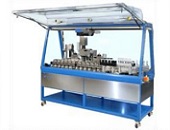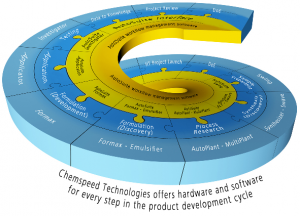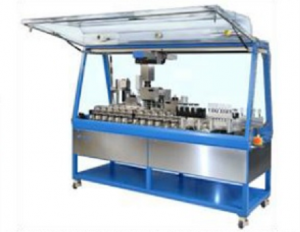“The iPhone of experimental chemistry” standardizes and simplifies experimental chemistry in a paradigm-shifting manner, according to Michael Schneider, SVP of Chemspeed Technologies, and the holder and author of more than 30 publications and patents. He was delivering a presentation on March 19, 2013, through a webinar organized by Chemical & Engineering News (C&EN).
“The iPhone of experimental chemistry” is based on a sleek desk-sized compartment that apportions chemicals in ”1-2-5” money analogously staggered (but in mmoles instead of cents) , ready-to-apply formats. It dramatically simplifies the experimental work in a multitude of “applications” in traditional experimental lab work and/or as instrument add-ons. The manufacture of these “iPhone apps” is done by Chemspeed’s precision robotics technology.
Dr. Schneider described the type of challenges faced by the chemical and energy sector: increasing constraints on chemicals and energy supplied by fossil fuels, increasing regulatory constraints (CO2 emissions, greenhouse gas limits, etc.), and increased demand for chemicals and energy. For example, at current rates of growth, energy demand will double by 2050.
Schneider emphasized that it is vital to standardize and accelerate R&D in order for a company to improve productivity and reproducibility of its R&D efforts. He was careful to draw a distinction between “high throughput” experiments and “high output” experiments. High throughput aims for a maximum number of elementary, automated experiments per unit time. High output aims for maximum information from automated experiments.
The “workflow platform” developed and manufactured by Chemspeed is the “technology backbone” that will help companies achieve high throughput and high output by multiple standardized runs under highly controlled conditions. (See picture; it’s larger than an iPhone.)
This Chemspeed platform can have any number of robotic tools and third party instruments operating on / with it. It can process a wide selection of racks, disposable vials such as the classic 96-well plate, and individually controlled, operated process reactors as well as formulation vessels. Schneider played several short videos that showed reagents being gravimetrically dispensed into racks of vials, and all vials being shaken (or stirred, or heated) according to the requisite protocol for different reactions. Even highly viscous materials can be gravimetrically added from the dispensers.
Schneider touched briefly on case studies using different configurations of the Chemspeed platform: impregnation, oxide and zeolite synthesis; nanolatex preparation; on-line analytics, to name a few. These all involved series of experiments needing uniform treatment (mixing, shaking, heating).
“There’s been a paradigm shift in polyolefin chemistry,” he said, of the final case study presented. Polyolefins, at the heart of plastics and petrochemical industries, require small amounts of very sensitive catalysts, which can even be self-igniting. The Chemspeed adaptation involves Chemspeed-designed all-glass pins that break at pre-defined pressures in order to instantaneously release the catalyst, or co-catalyst, or even the quenching agent to sharply stop the polymerization reactions.
By standardizing and accelerating R&D, it is possible to conduct many reproducible trial runs of a given experiment with little fuss. The R&D labs of top companies such as AstraZeneca and Sinopec have already realized the advantages of the Chemspeed workflow platforms. When throughput and output is high, then R&D can advance more swiftly, and that is how chemical companies can evolve swiftly to answer global challenges. ª
The webinar presentation slides can be found at: http://cen.acs.org/media/webinar.html
Dr. Michael Schneider can be reached at michael.schneider@chemspeed.com
Disclaimer: The author does not hold shares or receive commissions from any company mentioned in this article.



